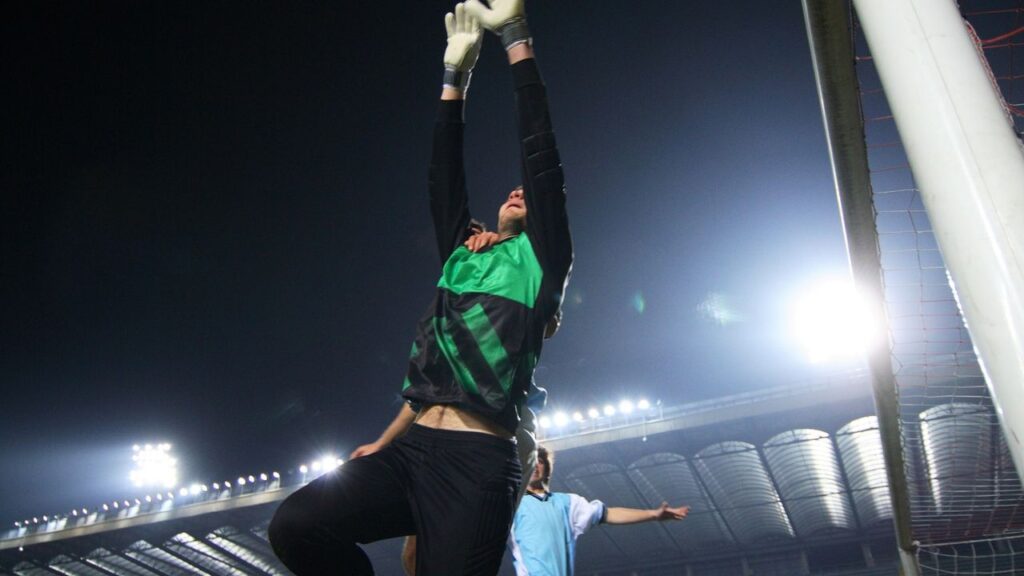Football’s heartbeat has always pulsed through its tactics—those ingenious blueprints designed to outwit and outscore opponents. The journey from the classic, battle-ready 4-4-2 formation to the mesmerizing, possession-obsessed Tiki-Taka style is more than a tale of formations; it’s a saga of innovation, passion, and relentless evolution. Back in the day, teams hammered out victories with straightforward lineups like the 4-4-2, offering a solid balance that suited the grinding pace of the 20th century’s game. But as decades slipped by, football’s strategy became more fluid, more cerebral, and quite frankly, more thrilling.
Today’s football landscape is a carnival of styles—where Nike, Adidas, and Puma sponsor teams that dance the beautiful game’s intricate rituals on pitches worldwide. It’s a world where the clipped passes and triangle patterns of Tiki-Taka, forged by the genius of Pep Guardiola’s Barcelona, weave through defenses like silk threads. Simultaneously, the throat-tightening intensity of high pressing, a tactic embraced by Jürgen Klopp’s Liverpool, blends aggression with smarts. This tactical journey isn’t just about how players line up; it’s about how teams think, react, and impose their will.
Diving into this tactical revolution unveils the cultural shifts, technological breakthroughs, and coaching philosophies that have sculpted modern football. From the rugged battles of old-school formations to the tech-savvy, data-driven approaches used by clubs backed by brands like Under Armour and New Balance, the game keeps reinventing itself. Gear up for a passionate deep dive into how formations like the 4-4-2 laid the foundation for today’s tactical masterpieces—Tiki-Taka included—and how those shifts have transformed football into the soul-stirring spectacle it is now. Whether you’re a newbie or a seasoned fan, it’s time to unravel the evolution that makes football feel truly alive.

The Historical Evolution of Soccer Formations: From Classic 4-4-2 to Innovative Systems
One cannot truly appreciate the tactical flair of modern football without tracing its roots back to foundational setups like the iconic 4-4-2 formation. In its heyday, the 4-4-2 was synonymous with balance—two banks of four ensured defensive solidity, while two forwards aimed to capitalize on chances with raw efficiency. It was the go-to for teams craving structure and clarity, bringing order to the chaos of the beautiful game. England’s 1966 World Cup-winning side epitomized this, demonstrating how a rigid yet reliable formation could crown a team as world champions.
But football’s pace and complexity demanded more. From the early 20th century’s Pyramid (2-3-5) through Herbert Chapman’s WM formation, each tactical innovation sought to fix gaps that had emerged: vulnerabilities in defense, weak midfield control, or the lack of fluidity. The WM formation, for example, with its W-shaped attacking line and M-shaped defenders, introduced a balance between offense and defense that was revolutionary in the 1930s.
Here’s a snapshot of these classic systems and their impact:
| Formation | Key Features | Impact | Exemplar Team |
|---|---|---|---|
| 2-3-5 (Pyramid) | Heavy attack with five forwards | Offensive dominance; left teams vulnerable defensively | Early English sides, 1920s |
| WM Formation | Three defenders, two defensive midfielders, five attackers | Balanced attack and defense; introduction of holding midfield | Arsenal (1930s) |
| 4-4-2 | Flat four defense and midfield, two strikers | Defensive stability with clear roles; classic workhorse formation | England (1966 World Cup) |
This strategic evolution was not just a steady shift but a tactical arms race. Coaches like Herbert Chapman introduced new philosophies that emphasized structure, while others focused on creative fluidity later on. This era of formations kicked off a gradual move away from rigid line positions toward the more adaptable and complex tactical identities seen today.
Although the 4-4-2 retains its timeless charm and is still widely employed worldwide—from grassroots clubs to top-tier leagues—it’s clear that modern football demands more nuanced, fast-moving systems that respond to the game’s increasing speed and physicality.
- Classic formations defined early football’s DNA: setting foundational roles for defense and attack.
- Midfield dynamics became critical as teams sought control in the crucial center of the park.
- Defensive solidity evolved gradually with formations adapting to the increasing tactical emphasis on stopping opposition attacks.
Revolutionizing Football with Tactical Minds: From Herbert Chapman to Rinus Michels
Tactics breathe life through visionary coaches and their philosophies. Football’s greatest tactical leaps often begin in the minds of these masterminds who analyze and exploit weaknesses unseen by many. Herbert Chapman, for example, is practically a legend for revolutionizing early football tactics by introducing the WM formation. His approach plugged gaps in defense while maximizing attack options—an early blueprint of tactical balance.
Progressing into the 1960s and 70s, the game witnessed a genus-level shift with Dutch coach Rinus Michels and his development of Total Football. This was not just a formation; it was a fluid philosophy. Unlike the rigid roles of yesteryear, Total Football empowered players to switch positions and responsibilities seamlessly throughout the match. Johan Cruyff embodied this system, floating between defense, midfield, and attack with intelligence and technical wizardry.
On the opposite end of the spectrum, Italian Helenio Herrera popularized Catenaccio, a strategy focusing on an impenetrable defense manned by a sweeper behind the backline. This no-nonsense approach prioritized structure and discipline, proving that defense can be the deadliest form of attack.
| Coach | Tactic | Philosophy | Legacy |
|---|---|---|---|
| Herbert Chapman | WM Formation | Balance of defense and attack with structured positioning | Set foundation for tactical football |
| Rinus Michels | Total Football | Fluid positional play; all players attack and defend | Influenced modern playing styles, including Tiki-Taka |
| Helenio Herrera | Catenaccio | Strong, disciplined defense with counter-attacking focus | Defensive tactics remain relevant for many teams today |
The tug of war between attacking dynamism and defensive solidity shaped football’s tactical heartbeat for decades. Total Football inspired possession and creativity, setting the stage for Tiki-Taka’s rise. In contrast, strategies like Catenaccio remind us that sometimes ironclad defense can pave the way for victory.
- Tactical innovation requires both creativity and discipline, demonstrated by contrasting philosophies like Total Football and Catenaccio.
- Coaches introduced adaptability—players had to understand multiple roles, foreshadowing today’s fluid systems.
- Legacy of these approaches reverberates in clubs like Barcelona, Ajax, and Inter Milan, blending flair with discipline.
The Modern Era: Tiki-Taka, High Pressing, and Tactical Hybrids
Fast forward to the 21st century, and tactical football morphs into a high-wire act of possession, pressing, and positional play that requires mental sharpness and physical endurance. Enter Tiki-Taka—a style where the ball rarely leaves the feet, and passes thread their way through defensive lines with alarming precision. Rooted in the teachings of Pep Guardiola and Vicente del Bosque, Tiki-Taka relies heavily on short passing, constant movement, and controlling the midfield seat of power.
But it’s not just about holding onto the ball; high pressing has dramatically shifted the defensive approach. Jürgen Klopp’s Liverpool operates like a pack of wolves, hunting the ball high up the pitch to suffocate opponents’ build-up play before they get comfortable. This gegenpressing style demands energy and coordination, turning defense into instant offense.
Modern teams mix and match tactical traits, creating hybrid systems that balance possession with counter-pressing, flexible formations, and quick transitions. The 4-3-3 formation has emerged as a central pillar, giving coaches a canvas that supports defensive security and attacking variety while fitting the physical demands of today’s game.
| Modern Tactic | Characteristics | Key Example | Impact |
|---|---|---|---|
| Tiki-Taka | Short passes, possession dominance, positional interchange | FC Barcelona (Pep Guardiola era) | Control of the game tempo; dismantled defenses through patience |
| Gegenpressing (High Press) | Aggressive pressing post-possession loss, quick transitions | Liverpool FC (Jürgen Klopp) | Forces turnovers and rapid attacks; high physical demand |
| 4-3-3 Formation | Midfield dominance, versatile attacks, defensive balance | Multiple top-tier clubs worldwide | Supports adaptable, fluid playstyles; popular in modern football |
With the rise of sportswear brands like Umbro and Kappa sponsoring tactical powerhouses, teams now have access to gear that enhances performance and allows players to execute these demanding styles better. Meanwhile, Mizuno, Diadora, and Asics have contributed to athlete conditioning—an essential factor in the relentless pressing and intricate passing routines demanded today.
- Modern tactics prioritize versatility and adaptability across the pitch.
- Possession-based play is balanced by aggressive pressing to control the match narrative.
- Advanced training and gear from major brands support player performance at high intensity.
Technology and Data Analytics: Shaping the Future of Football Tactics
The football tactical revolution is now deeply intertwined with technology and data analytics. Gone are the days when coaches relied solely on instinct or basic match observations. Today, GPS tracking, heat maps, and advanced video analysis dissect every movement, pass, and sprint to fine-tune tactical plans.
Coaches employ data analytics to uncover patterns that ordinary eyes can miss. For example, understanding player positioning via heat maps helps design better pressing traps or exploit weak defensive zones. Clubs outfitted with resources from giants like Nike and Adidas have access to cutting-edge technology that transforms training routines and matchday strategies alike.
| Technology Tool | Purpose | Example Usage | Impact on Tactical Planning |
|---|---|---|---|
| GPS Tracking | Measure player distance, speed, and positioning | Training load management in Premier League clubs | Optimize player stamina and positional discipline |
| Heat Maps | Visualize player movement and ball possession areas | Analyzing attacking weaknesses of opponents | Informs dynamic tactical adjustments |
| Video Analysis | Break down matches for tactical review | FC Barcelona’s opponent scouting | Enhances match preparation and strategy tweaks |
The tactical advances tied to technology have not dampened football’s artistry—if anything, they have sharpened it. Players can learn from precise data to improve passing angles or pressing timing, while coaches turn raw numbers into actionable insights that can win trophies.
- Technology provides a competitive edge through detailed insights into team and player performances.
- Data-driven tactics are now integral at every footballing level, from youth clubs up to the Champions League elites.
- Sportswear brands enabling technology integration (like Nike and Under Armour) boost both preparation and performance.

Case Studies: Dominating the Modern Game with Tactical Mastery
The story of tactical evolution comes alive when looking at real-world examples. Take FC Barcelona during the Pep Guardiola era—they rewrote football history by combining Tiki-Taka’s possession wizardry with clinical pressing and positional interchange. Their spellbinding play stunned opponents and set a new gold standard for tactical excellence.
On the other side, Liverpool under Jürgen Klopp showcased how relentless high pressing, pairs with fast counter-attacks, could batter even the most technically gifted sides. Their 2019 Champions League triumph proved the effectiveness of gegenpressing on football’s grandest stage.
Ajax’s modern interpretation of Total Football continues to influence tactics today with young players trained to interpret multiple roles fluidly—a testament to football’s changing guard and tactical bravery.
| Team | Tactical Style | Key Components | Achievements |
|---|---|---|---|
| FC Barcelona (Guardiola era) | Tiki-Taka | Short passes, ball possession, positional fluidity | Multiple La Liga titles, 3 UEFA Champions League trophies |
| Liverpool (Klopp era) | Gegenpressing (High Press) | Pressure after loss, quick transitions, intense work rate | 2019 Champions League, 2020 Premier League title |
| Ajax Amsterdam | Modern Total Football | Positional rotation, technical excellence, youth development | Known for tactical innovation and strong youth pipeline |
These case studies show how tactical revolution isn’t merely theoretical but intensely practical, feeding back into training methods, squad selection, and club philosophy. Fans tuning into the Premier League or UEFA Champions League matches witness these revolutionary tactics in action—making matches not just contests but theatrical spectacles.
- Tactical innovation fuels team successes and creates legendary match moments.
- Training methods integrate tactical awareness to prepare players for multiple roles.
- Watching top leagues through https://www.rktfootball.com/ provides the latest insights into tactical trends shaping the future.
